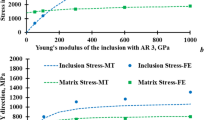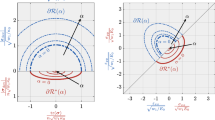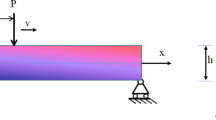Abstract.
A triangular grid method is presented to calculate propagation problems of elastic stress waves in 2-D orthotropic materials. This method is based on the dynamic equilibrium equations of the computational cells formed among the auxiliary triangular grids. The solution is obtained by calculating alternately the nodal displacements and the central point stresses of the spatial grids. The numerical results are compared with the corresponding solutions of the finite element method. Comparisons show that the triangular grid method yields a higher calculational speed than the finite element method. The stress concentrations are investigated from wave-field analyses when the stress wave propagates within an orthotropic plate with a hole. Finally, the presented numerical method is used to study the features of wave propagation and diffraction in a square orthotropic plate with a hole when an impact load is applied to the top of the plate.
Similar content being viewed by others
References
Hulbert, G.M.; Hughes, T.J.R.: Space-time finite element methods for second order hyperbolic equations. Comput Methods Appl Mech Eng 84 (1990) 327–348
Li, X.D.; Wiberg, N.-E.: Implementation and adaptivity of a space-time finite element method for structural dynamics. Comput Methods Appl Mech Eng 156 (1998) 211–229
Sibuya, J.; Nakahara, I.; Koizumi, L.; Kaibara, K.: Investigation of impact stress in a semi-infinite plate by finite difference method. Trans JSME (in Japanese) 40 (1974) 2997–3004
Steven, M.D.; Guang, Y.; David, J.W.: Dynamic stress changes during earthquake rupture. Bull Seism Soc Am 88 (1998) 512–522
Dineva, P.S.; Manolis, G.D.: Scattering of seismic waves by cracks in multi-layered geological regions I. Mechanical model. Soil Dyn Earthquake Eng 21 (2001) 615–625
Zhang, J.; Liu, T.: P-SV wave propagation in heterogeneous media: grid method. Geophys J Int 136 (1999) 431–438
Liu, T.; Liu, K.; Zhang, J.: Unstructured grid method for stress wave propagation in elastic media. Comput Methods Appl Mech Eng 193 (2004) 2427–2452
Virieux, J.: P-SV wave propagation in heterogeneous media: velocity-stress finite-difference method. Geophysics 51 (1986) 889–901
Jones, R.M.: Mechanics of composite materials. Washington, Scripta Book Company, 1975
Cook, R.D.: Concepts and applications of finite element analysis. New York, Wiley, 1974
Bathe, K.J.; Wilson, E.L.: Numerical methods in finite element analysis. Englewood Cliffs, Prentice-Hall Inc, 1976
Author information
Authors and Affiliations
Corresponding author
Additional information
This work was supported by National Natural Science Foundation of China (Nos. 10025212 and 10232040) and Natural Science Foundation of Liaoning province (No. 20021070).
Rights and permissions
About this article
Cite this article
Liu, T., Liu, K. & Zhang, J. Triangular grid method for stress-wave propagation in 2-D orthotropic materials. Arch Appl Mech 74, 477–488 (2005). https://doi.org/10.1007/s00419-004-0360-7
Received:
Accepted:
Issue Date:
DOI: https://doi.org/10.1007/s00419-004-0360-7




